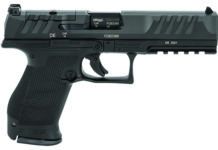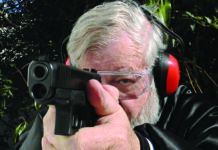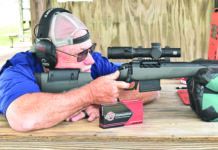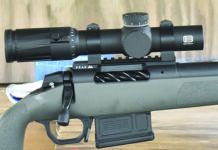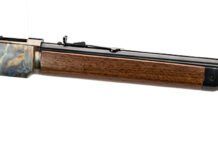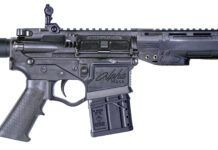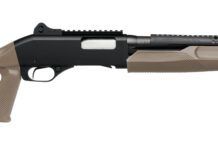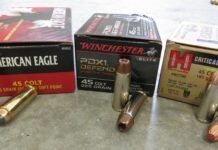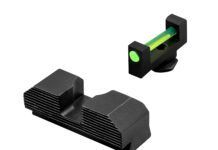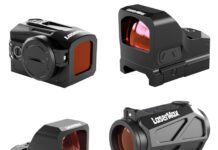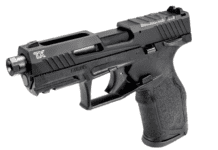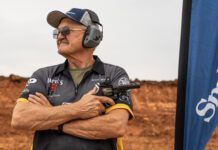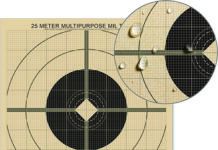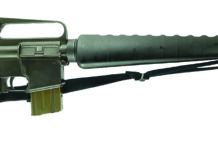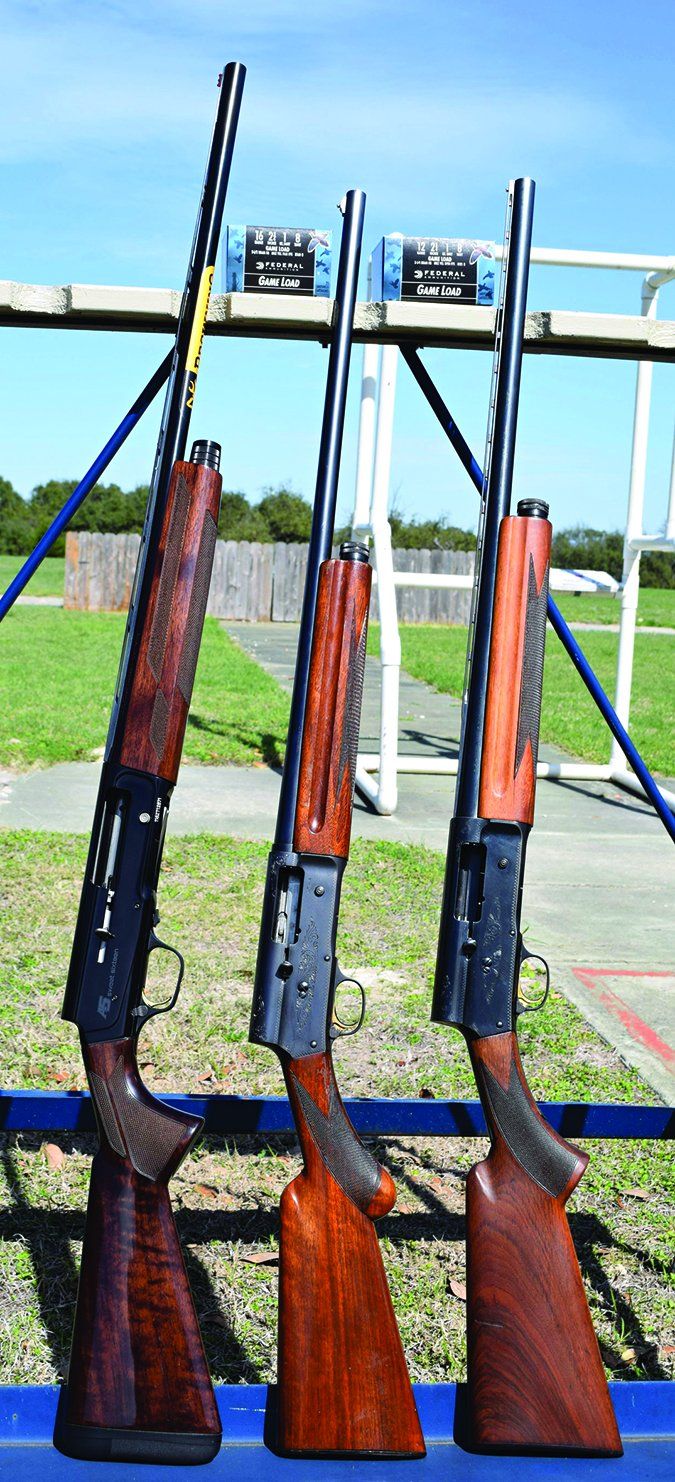
The popularity of the 16-gauge shotgun, in particular the Browning A5 Sweet Sixteen, has never waned among those select shooters with a streak of nostalgia in their genetic makeup. A common refrain of, “I’ve still got my granddad’s old 16 — best bird gun ever made,” is often heard whenever veteran shooters gather to share tales of old or create new memories of quality time in the outdoors.
Responding to a reader’s request, we decided to give the recently unveiled Browning A5 Sweet Sixteen that premiered at the 2016 SHOT Show a closer look to see what motivates the 16 gauge’s small, but very loyal, fan base. The new semiautomatic is built with a smaller, lighter receiver than the old-style Humpback and utilizes a different recoil system than the long-recoil creation of legendary firearms genius John M. Browning, so only time will tell if it has the lasting power of its predecessors.
To set up a comparison, we tested the following:
1. A new Browning A5 Sweet Sixteen listing for $1700;
2. A Browning A5 Sweet Sixteen made in 1960 that is available for about $650, and
3. A Browning A5 Light Twelve made in 1969, with a used-gun value of about $750.
The Light Twelve was added to the mix for a couple of reasons. First, the older Sweet Sixteen is built on the same-sized frame as the 12 gauge. Also, we wanted to see if the 16 gauge lives up to its reputation as a more sporting shooting tool. And, of course, 12-gauge ammunition is much more available than 16-gauge shotshells, and if the potential wingshooter is in the market for one of these Humpbacks, how much will nostalgia and pride of ownership of a “Sweet Sixteen” override the economics of shooting the bigger gauge, assuming similar performance?
We found, in fact, that the three Humpback Brownings provided a vivid demonstration of how handling ability, function, and patterning performance is different between what is new and what is old in a semiautomatic that revolutionized the U.S. shotgun market.
The Browning Auto-5 is recognized as the first mass-produced, semi-automatic shotgun; it was designed by John Browning in 1898, patented in 1900, and produced continually until 1998. The shotgun features a distinctive high squared-off back of the receiver — that is the reason for its nickname of the Humpback. It is a long-recoil-operated semi-automatic shotgun, the first of its kind. When a chambered shell is fired, the barrel and bolt travel backward from the recoil to re-cock the hammer. As a heavy recoil spring causes the barrel to return to its initial position, the bolt remains behind, and the spent shell is ejected through a port on the top of the receiver. Then the bolt returns forward and feeds another round from the magazine into the action. Humpback fans are well aware that the system is loud and seems to take a long time to function, but there is no doubt it works.
Our selection of ammunition to test the functioning ability, patterning performance and felt recoil of the semiautomatics was limited because of the lack of variety of 16-gauge shells on the market. We selected 16-gauge Federal Game 2.75-inch, 2.5-dram-equivalent loads packing 1 ounce of No. 8 shot with an average muzzle velocity of 1,165 fps for the two Sweet Sixteens; and 12-gauge Federal Game 2.75-inch, 3.5-dram-equivalent loads packing 1 ounce of No. 8 shot with an average muzzle velocity of 1,290 fps for the Light Twelve. Here are our findings:
Browning A5 Sweet Sixteen 16 Gauge, $650 (used)
GUN TESTS GRADE: B

A little harder to find — most owners simply don’t want to let them go at any price — this older model of the Sweet Sixteen made in 1960 functioned very well and handled almost the same as the newer version. With its lower price tag and factoring in the nostalgia element, we believe this veteran firearm is a slightly better choice than the new model introduced in 2016.
| ACTION | Semi-auto |
| CHAMBER SIZE | 2.75 in. |
| OVERALL LENGTH | 44.25 in. |
| CAPACITY | 5 |
| WEIGHT UNLOADED | 6.5 lbs. |
| BARREL LENGTH | 26 in. |
| BARREL | Blued |
| RECEIVER | Blued |
| CHOKE | Fixed, cylinder |
| BUTTSTOCK | American walnut |
| BUTTSTOCK LENGTH OF PULL | 13.5 in. |
| BUTTSTOCK DROP AT COMB | 1.75 in. |
| BUTTSTOCK DROP AT HEEL | 2.25 in. |
| FOREARM | American walnut |
| FOREARM LENGTH | 10.5 in. |
| FRONT SIGHT | Ramped brass bead |
| MID-BEAD | None |
| TRIGGER PULL WEIGHT | 4 lbs. |
| WARRANTY | None |
| TELEPHONE | (800) 333-3288 |
| WEBSITE | Browning.com |
| MADE IN | Belgium |
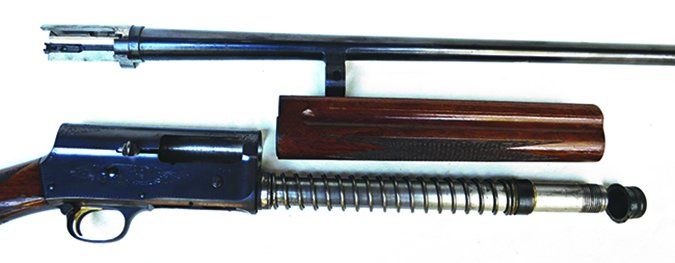
Finding someone willing to part with a veteran Sweet Sixteen, even for a short time for field testing, can be a daunting task. Running across one in the used gun rack at a firearm store is an even rarer occurrence. We were able to locate a nice used 16-gauge Humpback through the friend of a friend and immediately found there is quite a difference between the Sweet Sixteen of old and the 2016 version. The veteran shotgun, manufactured in 1960, has the heft and feel very similar to a Light Twelve, a 12-gauge version of the A5. For the members of our team with fond memories of hunting with the Humpback, that was fine; for the younger generation of shooters, the feel was clunky and heavy. The 57-year-old shotgun weighed in at 6.5 pounds, with a 26-inch barrel and an overall length of 44.5 inches. The 1 pound of weight and 4 inches of length difference between old and new was very noticeable.
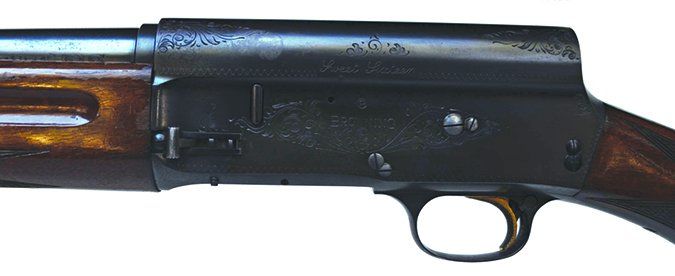
Concerning the other dimensions of the old Sweet Sixteen, the length of pull was short — 13.5 inches — but the drop at the comb of 1.75 inches and drop at the heel of 2.25 inches was identical to the new model. The trigger pull of an even 4 pounds was crisp and very well received by our shooting team.
We found that the veteran Sweet Sixteen required a little more adjustment to bring it to bear on targets. Even with the extra pound to its credit, there was noticeably more recoil with the older shotgun.
Also, the large ramped front sight was a distraction for some of our shooters during the beginning of the test, accounting for some target misses by having the shooter focus on the end of the barrel rather than on the clay target.
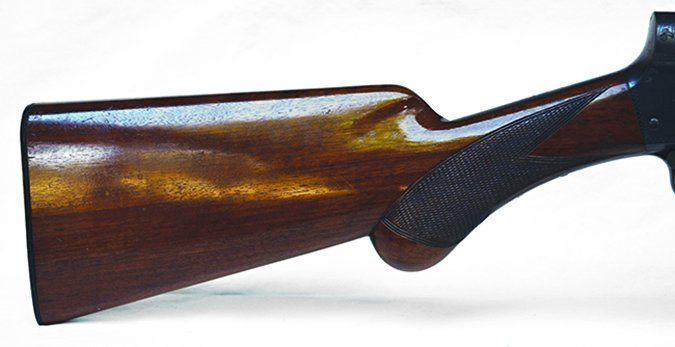
In addition, it should be noted that the fixed choke of the veteran shotgun was Cylinder, apparently designed for close-up shots like on skeet targets or quail flushed over good bird dogs. The open choke probably played a part in the patterning performance.
In the patterning tests, the old Browning produced a 63-37 percent spread, with two 3-inch holes in the upper left and one each in the lower right and left quadrants. Not a deal breaker, but below the performance of the new kid on the block.
We experienced no malfunctions of any kind with the veteran 16. Spent shells were ejected with the authority experienced Humpback shooters know so well. Clay-target breaks were not as consistent as they were with the smoother-handling new Sweet Sixteen. We believe the more open choke and the less comfortable feel of the veteran 16 were the major factors in our less-than-stellar performance on targets.
Our Team Said: If a shooter is looking for a trip back in time to handle and shoot a legendary smokepole, the veteran Sweet Sixteen fills the bill better than its recently introduced predecessor. The main problem will be finding a Sweet Sixteen the owner is willing to let go of at a reasonable price.
Browning A5 Light Twelve 12 Gauge, $750 (used)
GUN TESTS GRADE: B+

A solid, smooth-functioning veteran dating back to 1969, this Light Twelve is still doing its job. Despite the name, it is much heavier than the others — one of the reasons some hunters turned to a 16 gauge rather than a 12.
| ACTION | Semi-auto |
| CHAMBER SIZE | 2.75 in. |
| OVERALL LENGTH | 45 in. |
| CAPACITY | 5 |
| WEIGHT UNLOADED | 7.75 lbs. |
| BARREL LENGTH | 26 in. |
| BARREL | Blued |
| RECEIVER | Blued |
| CHOKE | Fixed IC |
| BUTTSTOCK | American walnut |
| BUTTSTOCK LENGTH OF PULL | 14.5 in. |
| BUTTSTOCK DROP AT COMB | 1.75 in. |
| BUTTSTOCK DROP AT HEEL | 2.25 in. |
| FOREARM | American walnut |
| FOREARM LENGTH | 11 in. |
| FRONT SIGHT | Brass bead |
| MID-BEAD | None |
| TRIGGER PULL WEIGHT | 4.5 lbs. |
| WARRANTY | None |
| TELEPHONE | (800) 333-3288 |
| WEBSITE | Browning.com |
| MADE IN | Belgium |
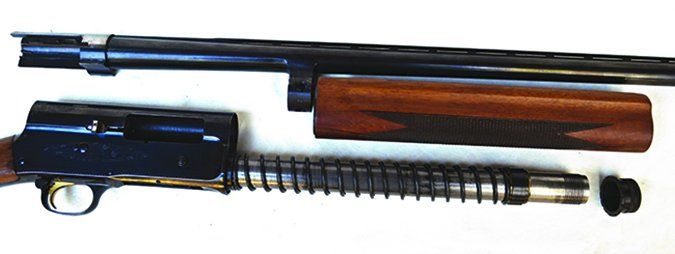
Before starting to detail the review process, it should be noted that several age-challenged members of our shooting team began their hunting days with an Auto-5 cradled in their arms. Putting that possible prejudice out in the open, we found the Light Twelve lived up to its reputation as the country’s second-most-favored semiautomatic shotgun, trailing the Remington 1100 that holds the top spot in the hearts of U.S. shooters.
As with the veteran Sweet Sixteen, the availability of a good, used 12-gauge Browning A5 is quite limited. We obtained the model we put through our tests courtesy of a shotgun enthusiast in Nebraska, who pointed out that the number of pheasants and quail the shotgun has brought to the ground over the years could not easily be counted.
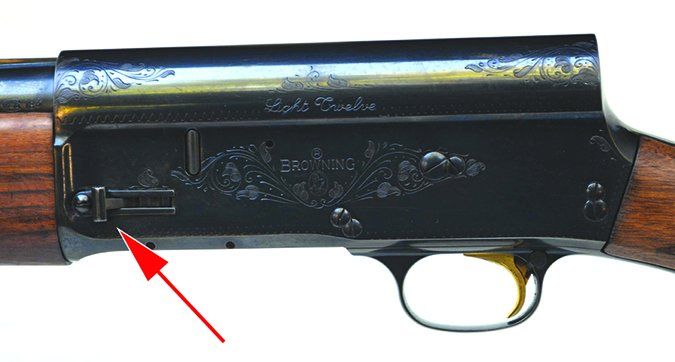
Sporting a 26-inch barrel with a fixed Improved Cylinder choke, our test Humpback was the heaviest shotgun in our trio, 7.75 pounds, with an overall length of 45 inches. This is a solid, well-designed shooting tool that is a credit to Browning’s ingenuity. As the old saying goes: “She may not be a looker, but boy can she cook.” Setting aside appearances — there are some who like the looks of an A5 and some who don’t — the semiautomatic has a very solid and balanced feel.
We found the fit to be acceptable with all members of our team. The length of pull was 14.5 inches; the drop at the comb was 1.75 inches; and the drop at the heel was 2.25 inches, exactly the same as the other two Humpbacks. The trigger pull of 4.5 pounds was nearly perfect for our tastes, and we were impressed with the reliability of knowing the shotgun had been providing quality service for nearly 50 years.

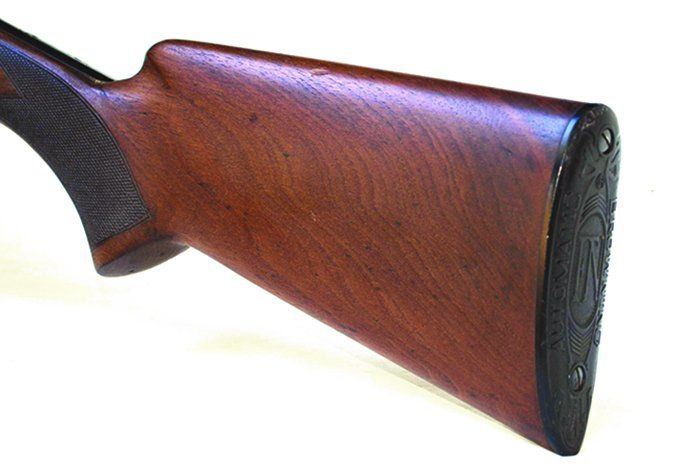
After our less-experienced shooters learned to “get over the hump” by focusing on the target and not the back of the receiver, target hits were both solid and consistent. The patterning board supported our high target breaking success with the veteran 12 gauge. The fixed Improved Cylinder barrel produced a 54-46 percent pattern, close to 50-50, which is what many shooters find to be the most favorable pattern.
The spread was nearly uniform throughout the 30-inch circle, with only one 3-inch hole on the very outer edge of the lower left quadrant. That is the type of spread that breaks more clays and downs more birds when the shooter is able to put the pellets in the right place at the right time.
There were no malfunctions of any kind with the Light Twelve. It is a workhorse that does its job as long as the shooter does his job. Concerning the question of whether shooting a 16 is more sporting than a 12, we found the answer to be, “It all depends on the shooter.”
Our Team Said: Availability, price, and performance on both the patterning board and on the range gave the Light Twelve a slight edge in our evaluation. This veteran creation of Browning still works well and has the historical feel desired by shooters with a touch of nostalgia in their souls.
Browning A5 Sweet Sixteen No. 0118005004 16 Gauge, $1700
GUN TESTS GRADE: B-

This is the new Sweet Sixteen, which gave us a bit of sticker shock from its price, plus several malfunctions during the test runs on the sporting clays course. Though this new offering from Browning ranked the lowest of our test trio, we should note that the new Sweet Sixteen did handle better and was more comfortable to shoot that either of its veteran predecessors.
| ACTION | Semi-auto |
| CHAMBER SIZE | 2.75 in. |
| OVERALL LENGTH | 49.25 in. |
| CAPACITY | 4 |
| WEIGHT UNLOADED | 5.75 lbs. |
| RECEIVER | Polished black (gold trigger) |
| BARREL | 28 in.; high-gloss blued steel |
| BARREL CHOKES | Invector-DS flush (IC, mod, full) |
| BUTTSTOCK | Grade 1 Turkish walnut, gloss finish |
| LENGTH OF PULL | 14.5 in., adjustable with spacers |
| BUTTSTOCK DROP AT COMB | 1.75 in. |
| BUTTSTOCK DROP AT HEEL | 2.25 in. |
| FOREARM | Grade 1 Turkish walnut, gloss finish; 11.25 in.; 18-LPI cut checkering |
| FRONT SIGHT | Red fiber-optic bar |
| MID-BEAD | White |
| TRIGGER PULL WEIGHT | 6 lbs.; gold color |
| WARRANTY | 1-year limited |
| TELEPHONE | (800) 333-3288 |

While the 16-gauge shotgun still finds a spot in the hearts of many veteran shooters, there is no argument that its popularity is well below that of any of the other gauges. The decline of the 16 gauge can very likely be tied to the creation of a then-new shooting sport developed in the mid-1920s.
As the official rules of American skeet were established in the United States, the .410 bore, 28 gauge, 20 gauge, and 12 gauge were included as standard competitions, but the 16 gauge was left out in the cold. In addition, trap shooting was evolving into a 12-gauge-only sport. Based on the snub of the gauge by clay-target shooters (many hunters still found the 16 to be more sporting than the 12), ammunition and firearms manufacturers saw the writing on the wall and limited their development of the old 16-gauge shotshell.
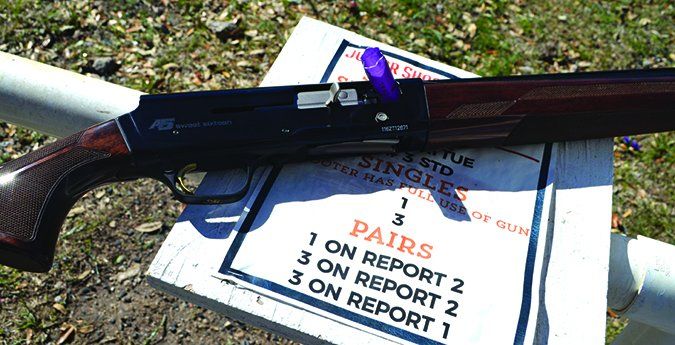
The ultimate dethroning of the 16 as a lightweight alternative to the 12 came with the development of 20-gauge loads that matched or exceeded the capability of 16-gauge loads. However, the interest in what many called the Sweet Sixteen never completely disappeared.
The folks at Browning apparently decided to stoke the historical desires of the 16-gauge crowd with the 2016 introduction of a new version of the Sweet Sixteen shotgun. While there is a resemblance to the venerable semiautomatic, the new Sweet Sixteen is lighter, softer shooting (it no longer uses the long-recoil system of the previous version), and more modern looking. The new Browning A5 Sweet Sixteen utilizes a short recoil-operated Kinematic Drive system that harnesses recoil energy and converts it into the mechanical motion needed to operate the action without the use of a heavy spring wrapped around the outside of the magazine tube.
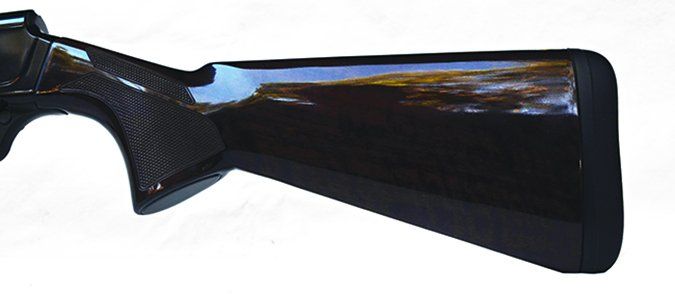
The looks and feel of the new Browning Sweet Sixteen semiautomatic are somewhat the same and somewhat different than the firearm that was the brainchild of legendary inventor and firearm genius John M. Browning. Its feel is similar to semiautomatics produced by Beretta and Benelli rather than that of the old Humpbacks, but that simply means the new Sweet Sixteen is a sleeker, smoother, more modern piece of shooting machinery.
Featuring a lighter alloy receiver as compared to the steel receiver of the old versions, the new Sweet Sixteen sports a 28-inch barrel and tips the scales at only 5.75 pounds. The shotgun’s overall length is 49.25 inches, with a length of pull of 14.5 inches (spacers are available to add to the LOP); a drop at the comb of 1.75 inches; and drop at the heel of 2.25 inches.
We found the new Sweet Sixteen feels and handles much like a 20-gauge semiautomatic. This light, quick, and easily maneuverable design was appreciated by our shooting team, particularly when we noted the felt recoil was much lighter than with the other two A5s.
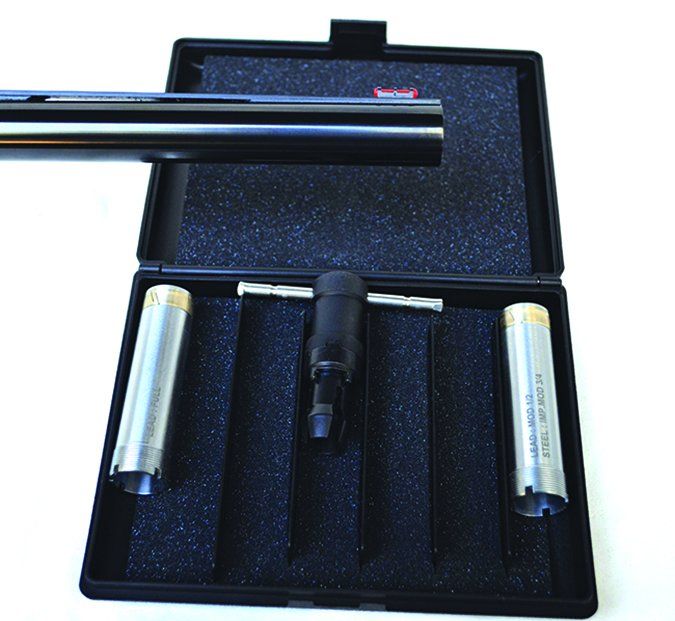
We found that the trigger pull of 6 pounds was heavier than we normally prefer, but was acceptable on the clay course, allowing us to produce satisfactory target trauma. There were about a half-dozen malfunctions with the first two boxes of ammunition, a fault we attributed to a lack of lubrication on the magazine tube and inside the receiver. Once a light coating of oil was applied to those areas, the function of the Sweet Sixteen was flawless.
On the patterning board, the Browning’s improved cylinder choke (a set of three Invector Double Seal chokes are included in the package) produced a very solid pattern in a 30-inch circle on a target set downrange at 30 yards. The pattern was 58-42 percent; that is, 58 percent of the hits above the center of the target and 42 percent below, with the only 3-inch hole in the even pattern found on the bottom left edge of the circle. There is no doubt that this solid pellet performance on paper was a major contributing factor to the number of clay target hits we experienced on the range.
While obviously different than the older versions of the A5, this Browning creation was comfortable to shoot, moved well, and produced top-quality breaks on target after target. When a firearm feels good, it just makes a shooter more successful on the range or in the field. That is exactly what we found with the Sweet Sixteen.
Our Team Said: Although we have concerns about the higher price tag of this A5 and did experience some malfunctions in the beginning of our tests, we found no other faults with the new Sweet Sixteen. We were particularly impressed with the patterning and handling ability of the new version of an old shooting friend.
Written and photographed by Ralph Winingham, using evaluations from Gun Tests team testers.


